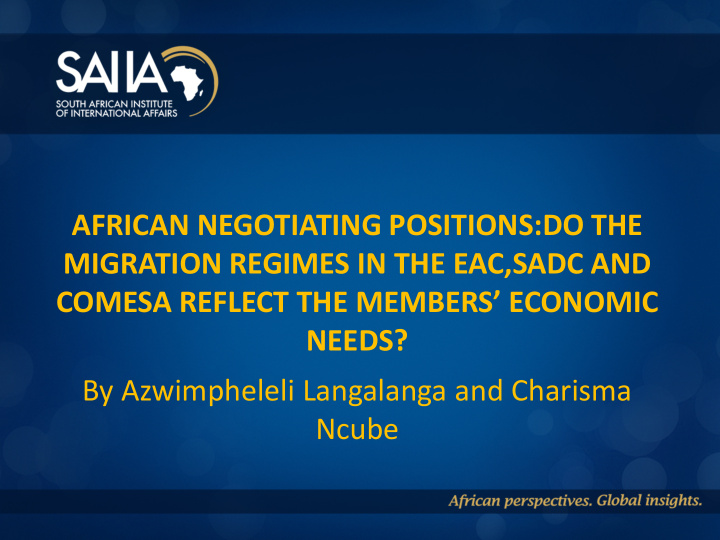



AFRICAN NEGOTIATING POSITIONS:DO THE MIGRATION REGIMES IN THE EAC,SADC AND COMESA REFLECT THE MEMBERS’ ECONOMIC NEEDS? By Azwimpheleli Langalanga and Charisma Ncube
OUTLINE AND RESEARCH PURPOSE Presentation Outline Migration in COMESA (Case Study: Rwanda and Zambia) • Migration in the EAC (Case Study: Tanzania) • Migration in the SADC (Case Study: South Africa) • Approaching the Tripartite Free Trade Area •
Purpose of the Research To explore the different legal regimes in the respective RECs. • Understand the extent of Implementation within RECs and MS. • Investigate the trade-migration nexus in migration protocols. • Assess how migration should be factored into the TFTA. •
MIGRATION IN COMESA Regional Instruments Protocol on the Free Movement of Persons,Labour,Services,Right of Establishment and • Residence 1998 Protocol on the Gradual Relaxation of and Eventual Elimination of Visa Requirements of • 1984 Success: One-Border Post Stop • Informal trade movement relaxation • Port of entry visas •
CHALLENGES IN COMESA Security issues • Non-Ratification • Uneven compliance • No link between migration and trade/economic imperatives ( GATS) •
MIGRATION IN COMESA Case Study: Rwanda Strong link between migration policy and development policy needs • Migrants Represented DRC(43%), Tanzania(31%), Burundi (14%), Uganda(11%) and others • African countries (1%) According to 3 rd Integrated Household Living Conditions Survey-International migrants in • Rwanda constitute 1/3 of the population Policies to enable Rwandan Diaspora to contribute towards economic development- • remittances Government simplified procedures to obtain documents in a reasonable time • Work permit for EAC citizens has been waived • Skilled experts attracted •
MIGRATION IN THE EAC Legal Regime Art 104 of the Common Market Protocol allows for free movement of • goods,services,capital and labour Annexure to the CMP on the free movement of persons and labour-sets out rights for • migrants Success: Ministries responsible for the EAC • One Stop Border Post and Harmonised procedures for issuing entry and work permits • Mutual Recognition of qualifications and EAC passport • Right to establishment and residence are enjoyed by citizens • Harmonisation of employment laws and policies • Bilateral Agreements that complement unique conditions between States e.g Kenya and • Uganda allows cross border movement of persons using an identity document as well as Kenya
MIGRATION IN THE EAC Implementation challenges: Slow implementation by some Members • Lack of funds • Poor infrastructure • Language barrier eg French v English • Lessons from the EAC: Harness labour migration as a vehicle for regional development • Collective Labour Migration Strategy key to poverty alleviation and employment creation •
Case Study: Tanzania Limits migration-evidence of clash between national and regional laws and polices • Phased out work permits req for EAC citizens • Uses GATS commitments to limit access into the labour market • Use professional bodies to restrict market access eg in law and medicine • Foreigners cannot own land-conflicts with right to establishment •
MIGRATION IN THE SADC Current Status Protocol on the Facilitation of Movement of persons, • 2005 Protocol on Employment and Labour,2014-(Right to Residence and Establishment) • Regional Labour Migration Policy Framework • SADC Charter of Fundamental Social Rights • *Note: SADC has not been able to effectively liberalise migration as it is very protectionist
IMPLEMENTATION CHALLENGES Poor ratification • Lack of finance and technical expertise • Lack of political will and commitment • No harmonisation of laws due to lack of a clear regional framework • National laws and policies are used to limit migration-work permits requirements •
MIGRATION IN THE SADC Case Study: South Africa Immigration Act 13 of 2002 as amended in 2004 • More restrictive migration framework • Thirteen types of permits • No framework to deal with economic migrants-Licensing of Business Bill • Xenophobia •
GREEN PAPER HIGHLIGHTS SA has a sovereign right to manage international migration in light of its national • interests The need to orient the countries international migration policy towards Africa. • Nation-building and social cohesion are identified as some outcomes of the country’s • international migration policy There is a need to for SA’s international migration policy to enable South Africans living • abroad to contribute to national development priorities. DHA argues that this paper must “balance the primary imperatives of economic • development, national security , international and constitutional obligations.
ISSUES ARISING FROM STUDY SADC there is no appetite to ratify protocols • Economic asymmetries are problematic • Move towards a needs based approach in SA • EAC- lot of progress but still MS use domestic to limit save for Rwanda • COMESA- less ratification •
APPROACHING THE TFTA NEGOTIATIONS Covers 29 countries will be covered with an estimated GDP of US$1,2 Trillion translating • to 60% of Africa’s total GDP. TFTA negotiations currently underway and will lead to deeper economic integration • Based on principles of market integration, infrastructure development and industrial • development Realisation of TFTA objectives of development and market integration need to allow for • easier movement of people Inevitably, the challenges faced by RECs will be transposed into the TFTA • The adoption of a GATS oriented economic approach would be streamlined with • individual member state’s economic needs in a way that enhances implementation and development.
THANK YOU
Recommend
More recommend